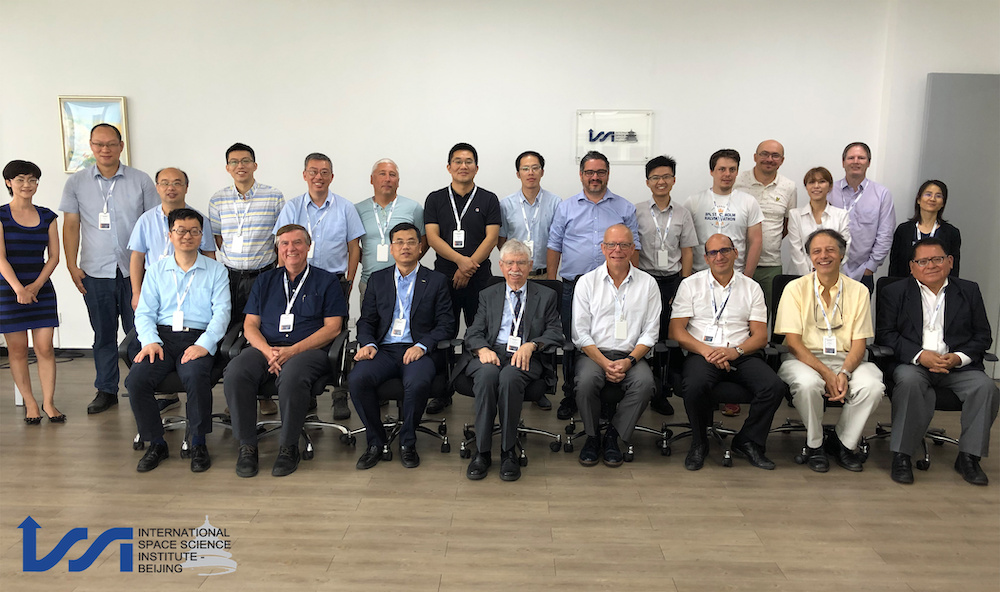
Group picture of the forum participants
Aiming to advance the research on the magnetic reconnection phenomenon, the forum conveners — Walter Gonzalez (INPE, Brazilian Academy of Science, Brazil), Vytenis Vasyliunas (Max Planck Institute, Germany), Chi Wang (NSSC, CAS, CN), Lei Dai (NSSC, CAS, CN), Malcolm Dunlop (RAL and BUAA, UK and China), Philippe Escoubet (ESTEC, ESA), Vassilis Angelopoulos (UCLA, US), Giovanni Lapenta (KU Leuven, Belgium), Tai Phan (UC Berkeley, US), Larry Kepko (NADA/GSFC, US), Alessandro Retino (LPP, Ecole Polytechnique, France), Michael Hesse (University of Bergen, Norway), and Maurizio Falanga (ISSI-BJ, CN) — invited and attracted renowned international personalities from the space science field, such as Prof. Lev Zelenyi (IKI, RAS, Russia), Prof. Rumi Nakamura (Space Research Institute, Austrian Academy of Sciences, Austria), and many other leading scientists from NASA, ESA, UCLA (US), UC Berkeley (US), and LPP (France), among others.
Given the need of improved understanding of magnetic reconnection (i.e. the conversion of magnetic energy into particle energy as two magnetic field lines tangle and “reconnect” in the plasma) on the electron-kinetic, the ion-kinetic, and the Macro-scale which are investigated respectively by the ESA’s Cluster mission as well as the NASA-led THEMIS and Magnetospheric Multiscale missions (MMS, and further enriched by the recently observed first interplanetary shock, the forum strove to provide an overview on magnetic reconnection, on its cross-scale science as well as in the solar-terrestrial connection to lay the groundwork for the debate on current spacecraft missions and international collaborations.
In fact, the forum participants were also given the chance to explore the Self-Adaptive Magnetic Reconnection Microscope Mission (SAMRM) formulated by the NSSC in 2016, which aims to make simultaneous and self-adaptive measurements of plasmas at electron-ion-macro scales with a fleet of 12+ CubeSats and one mother satellite. On the basis of this newly initiated Chinese mission as well as of all other space missions researching the fundamental questions on magnetic reconnection — such as when it occurs — the forum focused specifically on the macro-scales of reconnection, which are deemed to represent the key point to define main magnetospheric plasmas and fields changes due to reconnection.
Spanning over two days, the forum started with an overview of magnetic reconnection and the Constellation missions (Cluster, PROSPERO, SAME, MagCon, MMS), moving then to the cross-scale and multiple-scale science of reconnection, including cross-scale measurements, all presented by 15 competent scientists from leading institutions. As the second day began, the symposium on the cross-scale science of reconnection continued, bringing in turbulence, electron acceleration, waves, and MI-coupling as additional points of discussion in regard to reconnection and related to the space missions and their measurement approaches.
As ISSI-BJ intends to serve as a neutral ground for high-quality scientific research internationally, the two-days intense schedule was then concluded by the overall remarks on the Self-Adaptive Magnetic reconnection Explorer mission (SAME), on the questions posed and the ones answered, and on international cooperation opportunities.
For this reason and for the purpose of involving the non-expert community, ISSI-BJ regularly releases a forum-related magazine, TAIKONG; the new issue based on the forum “Cross-scale measurements of space plasmas to explore magnetic reconnection” will be published and distributed to the science communities and space science institutions in the following weeks, and it will also be made available on ISSI-BJ website.
---
For more information, please contact ISSI-BJ PR and Editorial Manager Laura Baldis: laura.baldis@issibj.ac.cn